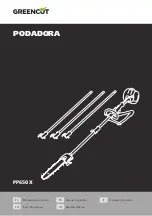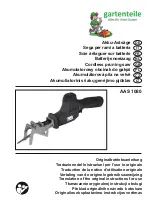
8 –
English
SAFETY INSTRUCTIONS
General safety precautions
•
A power cutter is designed to cut hard materials, such as
masonry. Observe the increased risk of kickback when
cutting soft materials. See instructions under the heading
How to avoid kickback.
•
Do not use the power cutter until you have read the entire
contents of this Operator’s Manual.
All servicing, in addition to the points listed in the section
”Control, maintenance and service of the power cutter’s
safety equipment”, should be carried out by trained
service specialists.
•
Never use the machine if you are tired, if you have drunk
alcohol, or if you are taking medication that could affect
your vision, your judgement or your co-ordination.
•
Wear personal protective equipment. See instructions
under the heading Personal protective equipment.
•
Never use a machine that has been modified in any way
from its original specification.
•
Never use a machine that is faulty. Carry out the checks,
maintenance and service instructions described in this
manual. Some maintenance and service measures must
be carried out by trained and qualified specialists. See
instructions under the heading Maintenance.
•
Never allow anyone else to use the machine without first
ensuring that they have understood the contents of the
operator’s manual.
•
Never use the machine indoors. Be aware of the dangers
of inhaling the engine’s exhaust fumes.
Transport and storage
Do not store or transport the power cutter with the cutting
blade fitted.
Store the power cutter in a lockable area so that it is out of
reach of children and unauthorised persons.
All blades should be removed from the cutter after use and
stored carefully. Store cutting blades in dry, frost free
conditions.
Special care should be taken with abrasive discs. Abrasive
discs must be stored on a flat, level surface. If blades are
supplied with a backing pad then a spacer should be used to
keep them flat. If an abrasive disc is stored in humid
conditions, this can cause imbalance and result in injury.
Inspect new blades for transport or storage damage.
Fuel safety
(Refuelling/Fuel mixture/Storage.)
•
Never refuel the machine while the engine is running.
•
Make sure there is plenty of ventilation when refuelling or
mixing fuel (petrol and 2-stroke oil).
•
Move the machine at least 3 m from the refuelling point
before starting it.
•
Never start the machine:
- If you have spilt fuel on it. Wipe off the spillage and allow
remaining fuel to evaporate.
- If you have spilt fuel on yourself or your clothes, change
your clothes. Wash any part of your body that has come in
contact with fuel. Use soap and water.
- If the machine is leaking fuel. Check regularly for leaks
from the fuel cap and fuel lines.
•
Store and transport the machine and fuel so that there is
no risk of any leakage or fumes coming into contact with
sparks or naked flames, for example, from electrical
machinery, electric motors, electrical relays/switches or
boilers.
•
Always store fuel in an approved container designed for
that purpose.
•
When storing the machine for long periods the fuel tank
must be emptied. Contact your local petrol station to find
out where to dispose of excess fuel.
•
Always use a Husqvarna fuel container with an anti-spill
valve.
!
WARNING! Take care when handling fuel.
Bear in mind the risk of fire, explosion and
inhaling fumes.
!
WARNING! Bear in mind the risk of fire,
explosion and inhaling fumes. Stop the
engine before fuelling. Do not fill so that the
fuel runs over. Wipe up all spillage on the
ground and machine. If you spill fuel on
yourself or your clothes. Change your
clothes. Move the machine at least 3 metres
away from the refuelling area before starting.
Содержание VentMaster 3120K
Страница 23: ......









































